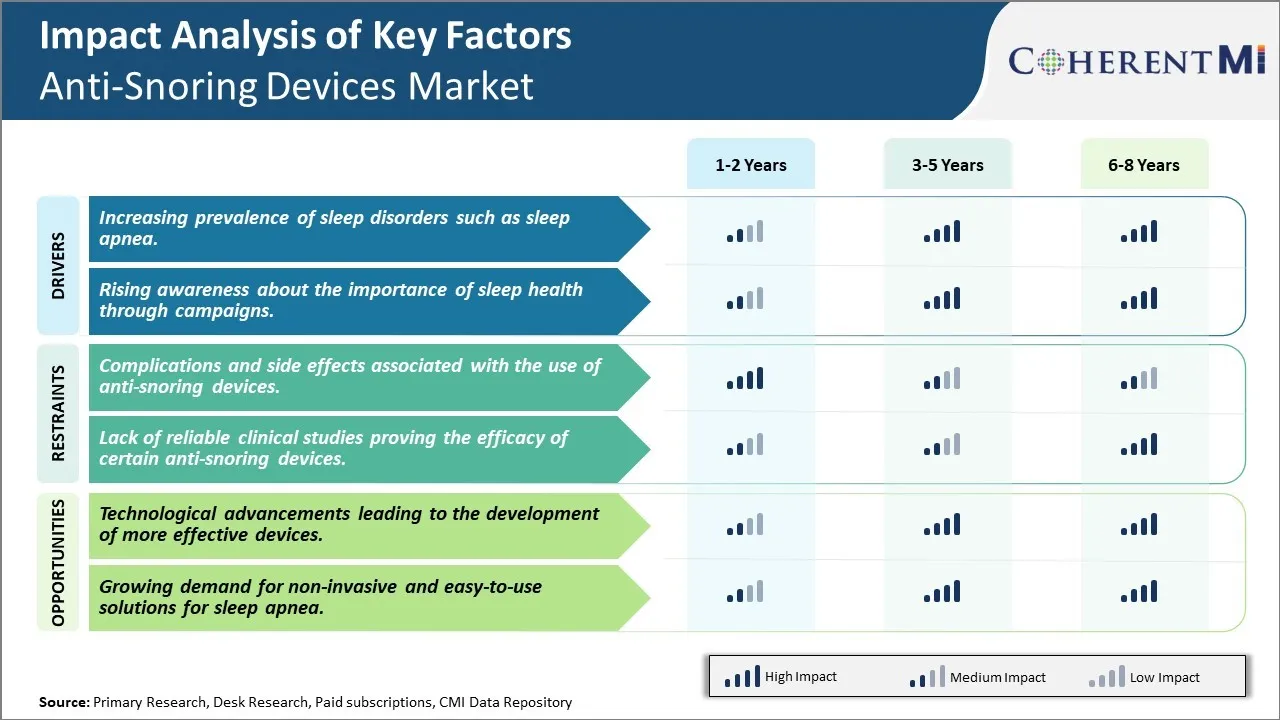Anti-Snoring Devices Market Trends
Market Driver - Increasing prevalence of sleep disorders such as sleep apnea
The increasing prevalence of various sleep disorders like sleep apnea across the globe has been a major driver for the anti-snoring devices market. Sleep apnea refers to a potentially serious sleep disorder that disrupts one's normal breathing pattern during sleep. There are various types of sleep apnea but the most common one is obstructive sleep apnea wherein the muscles relax around the throat whilst sleeping and block the airway, causing breathing to stop briefly. The person usually starts breathing again with an abrupt snort or choking sound as the upper airway muscles relax again. Sleep apnea causes oxygen levels in the blood to drop which disturbs the person's sleep as the symptoms can persist throughout the entire night.
According to various estimates, sleep apnea currently affects over 1 billion people worldwide with prevalence rates estimated to be as high as 38% among men and 16% among women. The rates are even higher among the elderly population. The main causes can range from obesity and excess weight gain to aging and genetics. Both obstructive sleep apnea and central sleep apnea disrupt a natural night of sleep and prevent the person from falling into the deep, dreaming stages of sleep needed to feel refreshed in the morning. Long term effects can contribute to serious health issues such as high blood pressure, heart disease, diabetes, and stroke if left untreated.
The standard treatment option for moderate to severe sleep apnea involves CPAP therapy which provides continuous positive airway pressure through a mask during sleep to keep the airways open. However, CPAP adherence has always been a challenge due to issues like discomfort, dry mouth, and claustrophobia making alternative treatment options attractive. This is where anti-snoring devices have gained popularity as an effective method to alleviate snoring caused by sleep apnea which disrupts partner's sleep too. Mouthpieces and nasal devices help improve breathing by opening the airways during sleep and reducing episodes of cessation in breathing. Thus, the increasing disease burden of sleep apnea globally has spurred demand for anti-snoring devices as a treatment and preventive measure.
Market Driver - Rising awareness about the importance of sleep health through campaigns
Rising awareness among general public regarding the importance of maintaining healthy sleep hygiene and the risks associated with inadequate sleep has been another key factor driving greater adoption of anti-snoring devices. Various social media campaigns, online blogs and articles in print media have highlighted issues like the detrimental effects of disrupted sleep on health, productivity and wellbeing. With busier lifestyles and stressful work routines making good quality sleep elusive, people are realizing they need to take proactive measures to address sleep issues before they become chronic.
Campaigns by non-profit organizations as well as governments have focused on educating especially young white collar professionals, new parents and the elderly population on basic sleep tips, troubleshooting noise disruptions like snoring early, and understanding the link between poor sleep and diseases like diabetes, obesity etc. The message that healthy sleep should be priority, not compromised has been an important takeaway. Simultaneously, technological advancements have enabled the democratization of access to simple tools for common sleep conditions. Socially acceptable anti-snoring devices represent a preferable treatment solution compared to prescription sleep aids leaving an encouraging impression.
Manufacturers of anti-snoring products have also complemented awareness initiatives through effective digital marketing campaigns highlighting positive reviews and testimonials. The discreet, easy-to-use image has boosted acceptance of these devices for personal use and even gifting purposes.

Market Challenge - Complications and side effects associated with the use of anti-snoring devices
One of the major challenges faced by the anti-snoring devices market is the complications and side effects associated with the use of these devices. Anti-snoring devices work by changing the structure of the airways or jaw positioning which can sometimes lead to discomfort, pain or other issues for users. For example, mouthpieces that adjust the jaw positioning can cause teeth alignment problems or temporomandibular joint (TMJ) discomfort over prolonged usage. Nasal devices use straps or clips around the nose which may lead to irritation, congestion or nose bleeds in sensitive users. Some devices also alter the natural breathing pattern which can cause shortness of breath, dry mouth or headaches in certain individuals. The invasive nature of certain anti-snoring devices and the changes they induce in the delicate structures of the nose, mouth or throat make complications an inherent risk that limits widespread adoption. Device manufacturers need to focus on improving designs and making products more comfortable to use over long periods of time so as to reduce the risk of side effects for a larger consumer base. Addressing complications effectively is a challenge holding back further growth of the industry.
Market Opportunity - Technological advancements leading to the development of more effective devices
One key opportunity area for the anti-snoring devices market is the technological advancements leading to the development of more effective devices. Constant innovation is introducing new product categories and better product designs that are more effective in treating snoring issues. For example, the introduction of respiratory polygraphy has allowed tracking of sleep patterns more precisely, helping develop oral appliances that better target obstructive sleep apnea. Advancements in materials allow for lightweight, durable devices made of comfortable silicone or memory foam instead of bulkier plastic options of the past. Electronic sensors and tracking offer potential for monitoring adherence and automating adjustments. Rapid prototyping enables easy, low-cost trials of new prototypes. The increasing digitization of healthcare also opens new opportunities for connectivity with sleep monitoring apps and remote diagnosis. Overall, continued innovation expanding the treatment scope and improving user experience of anti-snoring devices presents a strong opportunity for industry players to explore and drive future growth.